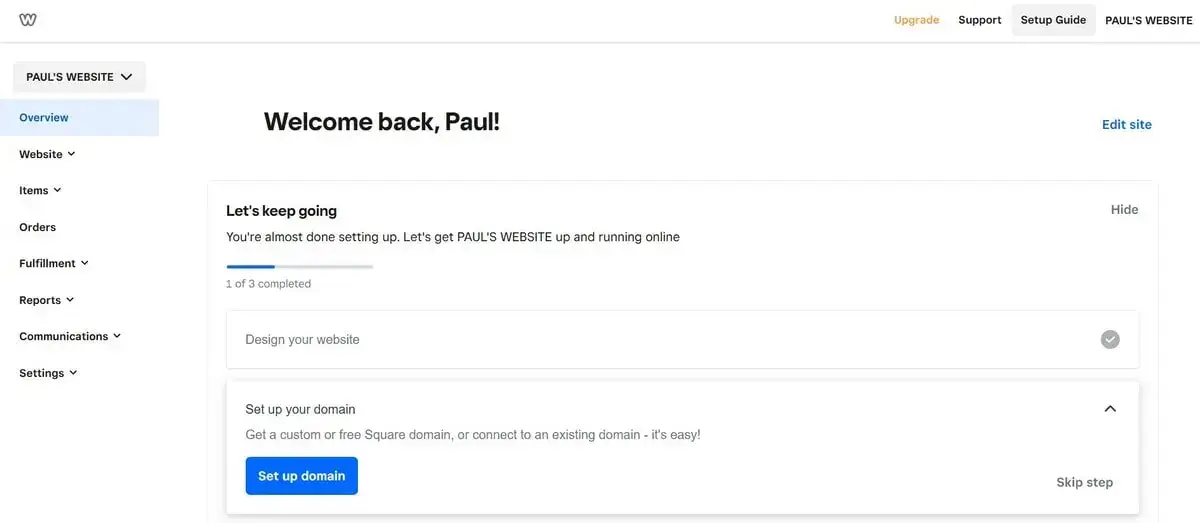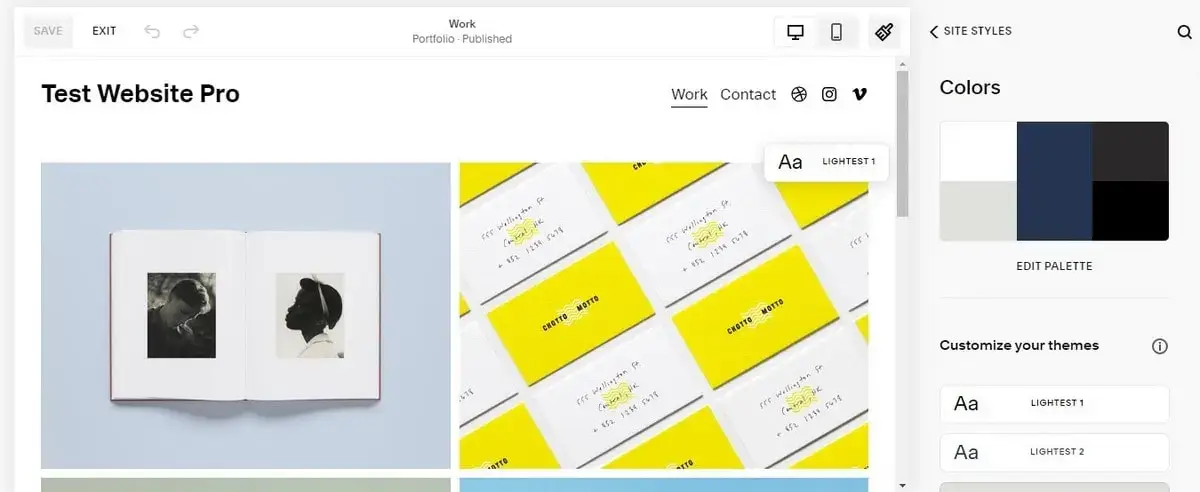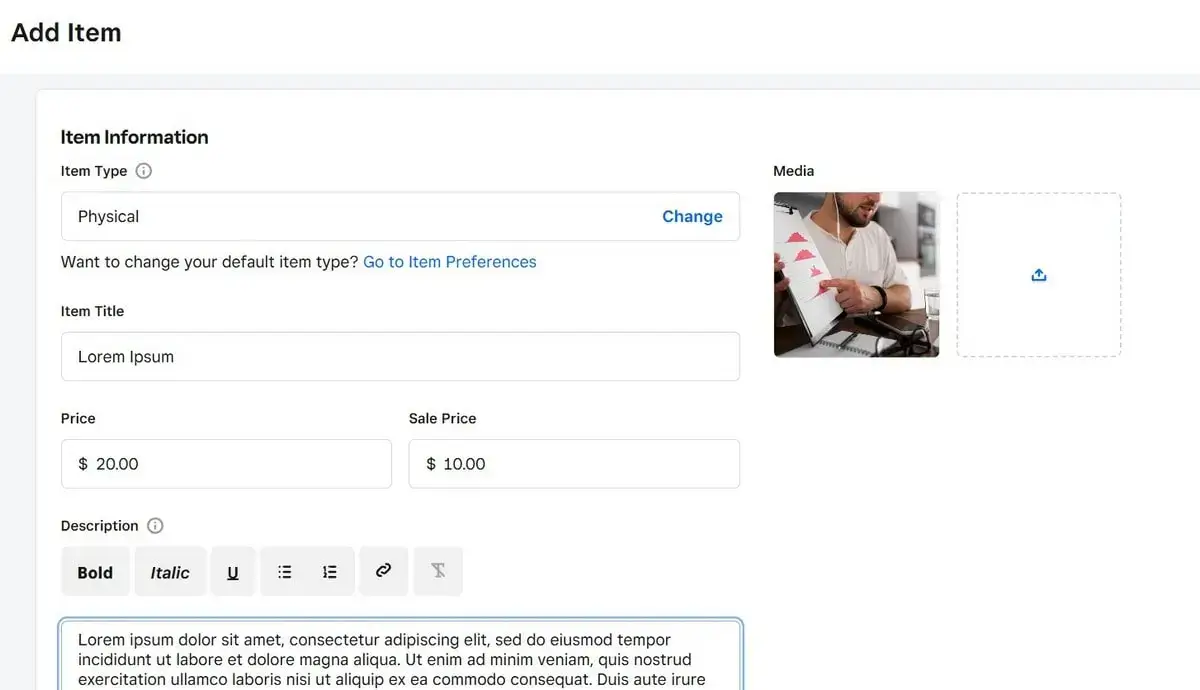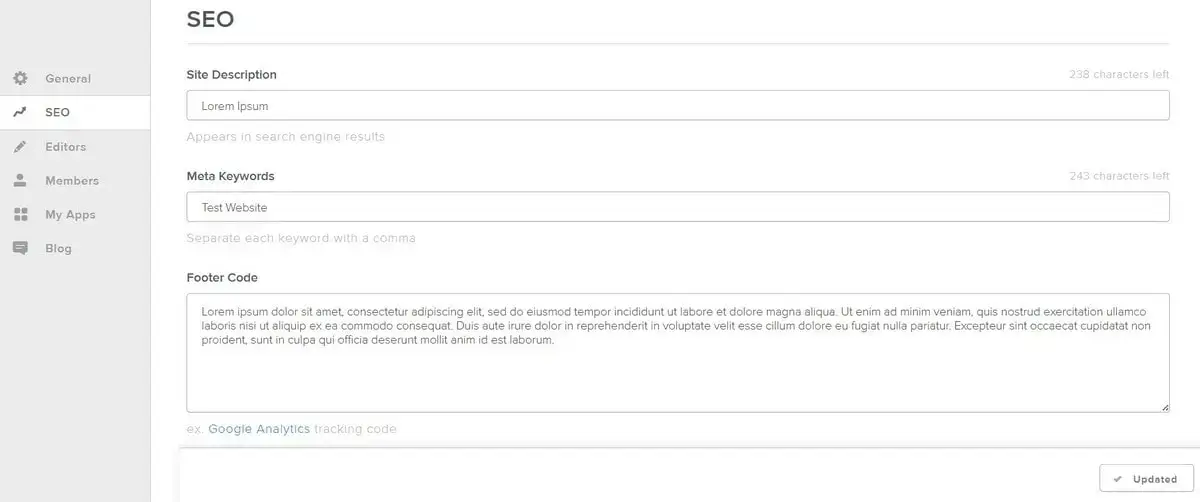The site-building market has everything your creative project might need today, and the only snag is which software to use to bring your website to reality. Two popular solutions are Weebly and Squarespace. Any of them is capable of creating beautiful, fully functional sites. Likewise, each system has features and tools to talk about before making the final choice.
- Weebly, which is now owned by Square, has initially been created with blogging focus in mind. Known for its user-friendly drag-and-drop interface and quite simple setup, the system works equally well for beginners and small businesses, especially for those willing to integrate eCommerce functionality.
- Squarespace is a more design-focused and content-driven platform, with a variety of customizable templates that appeal to artists, entrepreneurs and industry pros who prioritize brand presentation. The website builder is used not only for web store creation, but also for the development of other project types.
Obviously, the choice between Weebly and Squarespace is not a simple one and you can make a mistake if you fail to find out more about each system.
Before you dive deep in details, though, keep in mind that Weebly is not going to be developed anymore, although its support won’t be discontinued either. That’s what the company developers report in their recent update. Instead, they recommend switching to Square Online – niche-specific eCommerce software with numerous marketing benefits like Instagram integration, versatile templates, code embedding option etc.
This may be a notable reason for former Weebly subscribers to switch to another system, preferably a website builder. In this case, it will make sense to hire a professional to help you.
If you realize this need as well, I’m ready to offer professional transfer services like those from Weebly to Wix or from Weebly to WordPress, for example. Still interested in learning more about Squarespace? Go ahead to view the comparison below.
1. What’s the Core Difference?
Weebly has been present in the market since 2007. This is an online site builder for non-techies that allows users to build professional websites of all sorts without spending much time and effort.

In 2018, the platform became part of Square Inc., a renowned company specializing in digital financial services. This has extended the capabilities of Weebly from online payment and sales perspectives. The platform offers an affordable pricing system with a free option on the list.
Squarespace started its operation in 2004. It was initiated as a beginner-friendly CMS for creating gorgeous, functionally powerful websites for any purpose. It soon won fame for its design options since the site builder was initially addressed to creatives.

Now, Squarespace ranks among the best web development platforms for eCommerce. The site builder has specific plans with enough tools for online store projects. Just like Format (see the comparison) and other popular portfolio-creation platforms, Squarespace can be effectively used by creatives. At the same time, you can set up and run other project types with it – welcome pages, business websites, blogs or whatever.
2. Which One Offers a Smoother Start?
How steep are the site builders under review to cope with? Do they require coding skills? These might be fundamental questions for many users. The answers may determine if the software will be used at all. So, let’s compare the usability of Weebly and Squarespace first.
In terms of affordability for non-techies, Weebly is an excellent choice. The site builder offers a simple starting process. It allows users to quickly sign up, pick a suitable plan, and create a website. Weebly’s plans include free hosting, SEO, and other basic features.
Weebly has an easy-to-use WYSIWYG editor with an intuitive interface and simple tools. You’ll need to take these steps to launch a ready website with the help of Weebly:
- Choose a template.
- Customize the chosen template’s design without adjusting the code.
- Connect the necessary apps.
- Publish the website with a click.
Weebly can supply the simplest projects with a free domain (it’ll end with ‘weebly.com.’) Getting a custom domain is available within all premium plans, and the possess is also very simple.
In comparison with Weebly, Squarespace’s editor looks a bit more complicated. This is due to a larger set of tools and features. Yet, the platform’s editor offers a simple drag-and-drop-based creative process. A user with zero coding and web design knowledge can easily create an account with Squarespace and proceed with the site-building process. It’ll be simple, mainly thanks to AI-powered assistance and constant prompts.

From the beginning, this interactive system will guide you through your choice of a plan and fitting set of instruments (an online store or non-eCommerce project, the purpose of a website, etc.) Regardless of your chosen plan, you won’t need to search for a host. The custom domain option is also supported.
The editor’s interface is a pleasure to work with. It is not as effortless as the one offered by Weebly, but it represents a balanced combination of functional power and easy access to all instruments.
So, creating and publishing a website on Weebly and Squarespace are straightforward processes. Weebly is simpler, but its tool supply is weaker. Squarespace remains in the list of the easiest site builders, though its editor offers a much broader range of instruments than Weebly.
Read also: The Easiest Way to Make a Website.3. Design Tools and Templates Comparison
How effective are Weebly and Squarespace from a design perspective? Let’s compare these platforms’ template libraries and design possibilities.
Weebly offers around 50 templates grouped by purpose (business, portfolio, blog, etc.). They may fit a simple website run by a total beginner, but for a serious company or an ambitious entrepreneur, the choice of Weebly’s templates will be insufficient – in terms of both quantity and quality. Many themes are openly out-of-date.

As for the Weebly editor’s capabilities, they are pretty limited. The editor is strictly structured, and its customization options are scanty. That is, you’ll be able to drag and drop blocks only into certain places of the grid – not into whatever spot of the page is under construction. Without coding, you can only customize fonts, colors and styles.
Squarespace still outperforms most site builders and CMS platforms (read the comparison with WordPress) in the quality of templates. Many competitors can suggest more than 100+ designs offered by Squarespace. Yet, these are stunning, professionally built templates smartly grouped by purpose.

The platform’s editor is also based on drag-and-drop tech and is structured. However, the level of customization freedom with Squarespace is much higher than Weebly’s. Yes, Squarespace’s page layouts are pre-built but flexible. You can expect a sufficient choice for Product, Portfolio (compared with Adobe Portfolio layouts, for example), About or any other pages necessary for your online project. Some of the most significant design features in Squarespace include the following:
- Google & TypeKit fonts;
- Custom color schemes;
- Customizable content areas (photos, videos, quotes, charts, links, buttons, galleries, custom code, etc.);
- A built-in photo editor;
- Video & background banners;
- Video pages and animation tools;
- The duplicate page option;
- Custom CSS, and more.
So, Weebly and Squarespace have the same philosophy of easily accessible design for beginners. Yet, Squarespace offers more flexibility to users than Weebly. Its templates are the best in the industry so far. Weebly has an easier editor, but its possibilities are much more restricted.
Read also: How to Create a Personal Website4. What Can You Actually Build and Where Are the Limits?
Weebly and Squarespace both make it possible to create versatile website types. Weebly, however, is more focused on eCommerce projects. Overall, the website builder powers more than 1,710,792 websites, with over 272,446 being eCommerce projects.
Squarespace, in its turn, powers over 8,826,944 sites, mostly focusing on creative and content-driven projects like blogs, portfolios and small business sites. However, running small web stores is also possible here. Let’s see what system has to offer to its subscribers now.
eCommerce
Weebly is almost all about eCommerce now. After it became part of Square, the site builder improved its online commerce capacities. In cooperation with Square Online, the system now allows creating and running all types of online stores – from small ones to large supermarkets. The system has an integrated shopping cart, multiple product/order management options as well as access to inventory management tools. There is also the opportunity to use a tax calculator, Square gift cards, the Quick Shop option, In-Store Pickup and other features here. To be able to set up a large online store and get access to advanced eCommerce features, get ready to subscribe to a premium plan.

Squarespace was not created for web store setup. You can create a small or a medium web store here, using such features as: inventory management, order processing and analytics tools, unlimited products (starting from the Business plan), POS, smart accept-payment integrations, abundant tools for shipping, advanced discount and merchandising tools as well as API commerce, and many more. You can also choose between multiple eCommerce templates with regard to your web store specialization.

Integrations
Both Weebly and Squarespace allow extending your website functionality via external widget integration.
Weebly has an app store ready to provide over 100 worthy add-ons to your website. You can actually pick those that tackle your project specialization. These include tools like Google Analytics, Mailchimp, Facebook Ads etc. These apps help you track targeted marketing campaigns, analyze user behaviour, create and manage email lists. When browsing the App Center, you will also come across applications for eCommerce, social media, SEO, customer support and other requirements.

As opposed to Weebly, Squarespace does not have a built-in app store. So, if you feel that you will require more applications for your website, it can make sense to look for a trusted alternative.
Is Squarespace ok for you? Then go ahead to pick and use a number of extensions to cover your special web development needs – from advanced eCommerce tools and up to social media integration or customer relationship management. Among apps you can integrate here, it makes sense to mention those for restaurant/cafe websites, wedding projects etc., content creation tools for social networks like Unfold app, Logo Maker, video management apps like Squarespace Video Studio App and more. If you plan to schedule an event, the system will let you do that due to the integrated booking software available by default.
AI Tools
Looking for an AI website builder? Weebly and Squarespace offer this functionality as well. And Squarespace seems to be the clear winner here.
Weebly offers baseline AI functionality that includes a setup wizard, AI Copy Assistance (somewhat limited) and Square Business Integration (this feature is more eCommerce-specific than AI-powered, though). No other AI tools are available here and they won’t be introduced soon.
Squarespace, on the contrary, keeps integrating AI tools to its web development process. Its website builder (Fluid Engine) is powered by Artificial Intelligence now. The system also uses AI Text Generator, AI image and design tools, AI SEO suggestions, Copy Generator, Brand Identity Tool, Email Generator etc. New features are steadily introduced by the system as well.
Mobile Responsiveness
Mobile compatibility is a must in today’s reality. How capable are the platforms under review from this perspective? Let’s have a quick overview of their mobile strengths.
Weebly offers mobile-responsive templates. They automatically fit any screen. The only drawback of Weebly is that it does not support Preview options for all devices. You cannot observe how your pages will look on mobile smartphones or tablets before publishing.
All templates from Squarespace are also mobile-optimized. Its SEO tools include mobile optimization options. You can preview how your future website will look on all devices. Thus, both platforms are mobile-effective, with a little advancement of Squarespace over Weebly.
SEO and Marketing
Indispensable features for all individual or business projects include SEO and marketing tools. Weebly and Squarespace have similar approaches to the matter but cope with it a bit differently.
All Weebly plans go with built-in SEO. This is a great option for beginners who can create web pages automatically optimized for search engines. You can edit your page URLs, titles, and descriptions. Weebly offers the SEO Checkout and SEO Guide for starters.

Marketing tools include Lead Capture and Instagram Feed. Only paid plans allow for the Pop-up Notifications feature. Smart insights will be available only within the Performance plan.
Squarespace also includes built-in SEO in all its plans so that you can create SEO-friendly pages (for all desktop and mobile devices) without much effort. Updates for meta titles, descriptions, and page URLs are supported. You can modify Image Alt Text as well. Google Search Keywords and the SEO-friendly Translations option are on the list, too.

The marketing toolkit of Squarespace is more advanced than the one of Weebly. The feature list includes the following:
- Social selling tools.
- Mailing lists.
- Form blocks.
- Custom Favicon.
- Tools for creating banners & promotion pop-ups.
- Marketing analytics.
So, Squarespace gives more options than Weebly. While the platforms offer almost the same SEO tools, Squarespace goes a step ahead of Weebly regarding marketing instruments.
Performance and Speed
How long will your customers need to load your Weebly or Squarespace website? Let’s compare the platforms’ performances and speeds.
Weebly offers fast hosting within all its plans. The latest GTMetrix-based checks have displayed that Weebly websites load in less than 3 seconds, which is considered good. Their Web Vitals are not the best but quite passable.
Squarespace also provides its clients with lightning-fast hosting. Your Squarespace site will load in 2 seconds or faster. The platform’s GTMetrix data reveals Squarespace’s better performance than Weebly. Thus, Squarespace’s LCP is 1.3 seconds against Weebly’s 2.2 seconds. This means your Squarespace website will display its most massive content faster than the same Weebly site.
Security
Who wins the security race? Weebly or Squarespace? Let’s observe what both platforms can offer in this respect.
Weebly’s security options are pretty basic. All its plans include an SSL certificate. If you need more, you can only plug in third-party add-ons in the Weebly App Store.
Reliable SSL certificates are also included in all Squarespace plans. Yet, the platform has more built-in options:
- Anti DoS attacks measures.
- The 2FA option.
- Password-protected pages.
- The Login Activity panel to monitor all recent sessions made under your login.
- GDPR-compliant data privacy policies, and more.
So, Squarespace wins the palm. Its security possibilities are more advanced than those offered by Weebly.
Support and Community
Both Weebly and Squarespace offer responsive support to their customers. Users can contact specialists and use self-education guides.
Weebly offers live chat support from 6 AM to 6 PM, 7 days a week. Only users on the Performance plan can use phone support. Weebly offers a quality Knowledge Base. Its community forum also provides much info.
Squarespace offers no phone support. Its customer service works in the online chat mode 24/7. The platform has a massive Knowledge Base with exhaustive guides and webinars. Users can also join multiple forums (Squarespace Community, Women Who Code, etc.) and find answers to all possible questions a beginner might have during their creative process.
5. Which Platform Gives You More Value for Your Money?
Now, it’s time to compare the pricing systems of the platforms. Both Weebly and Squarespace offer four paid-per-month plans with free hosting, domain options, and variable sets of features. Let’s start with detailed Weebly pricing now.
Weebly plans are quite affordable, yet there are only two expensive plans that allow users to remove Weebly/Square ads from their website. Advanced analytics is available only within the Performance package. Yet, Weebly is a nice choice for the simplest sites since all its plans include features like an SSL certificate, a shopping cart, basic SEO, etc.
What about Squarespace? It does not have a free option. Although its plans are more expensive, they offer a better value for money.
- Mobile optimized websites
- Templates to fit every need
- Free custom domain
- Free invoices
- 0% transaction fee on invoices
- Advanced website analytics
- Opportunity to sell products and services
- Checkout on your domain
- Advanced shipping
- 3% transaction fee on online store transactions
- Powerful merchandising
- 0% transaction fee on online store transactions
- Advanced discounting
- Opportunity to sell subscriptions
- 0% transaction fee on invoices
- 0% transaction fee on online store transactions
All Squarespace plans come with an SSL security certificate, unlimited bandwidth, SEO, and other basics. Starting from the Business plan, Squarespace packages include integrated eCommerce and advanced analytics suites.
6. Which Website Builder Is Right for You?
Both Weebly and Squarespace are top-quality site builders designed to let users with little or no code knowledge create and launch their website projects without pain or hiring a specialist. Have a look at the lists of pros and cons that refer to both website builders.
Pros & Cons of Weebly
|
Pros: |
Cons: |
|
|
Pros & Cons of Squarespace
|
Pros: |
Cons: |
|
|
Thus, Weebly offers a free option and cheaper plans, but its functional capacities are more restricted. So, Weebly might be a great choice for individual users or tiny businesses on a tight budget. At least, their Weebly website will look professional and allow them to conduct simple transactions online.
Squarespace is a more powerful web building tool. It can build multi-functional online stores, blogs, portfolios, etc. The platform’s key advantage is its premium-class templates with advanced customization options. The site builder is better equipped in terms of security, loading rate, marketing/eCommerce feature supplies, etc., than Weebly.
Squarespace’s plans are more expensive when compared with Weebly and other builders of the same class. Yet, Squarespace is the optimal solution for small to medium-sized businesses and eCommerce projects, thanks to a well-thought-out balance between 100% usability and high effectiveness potential.
